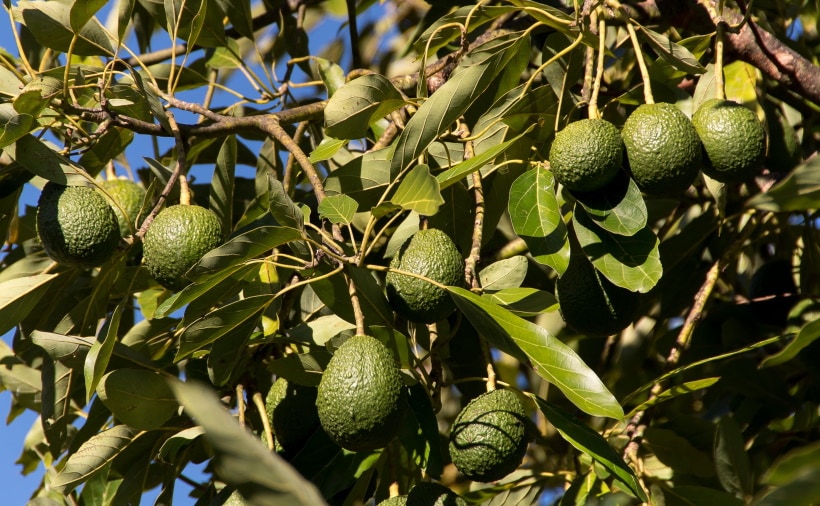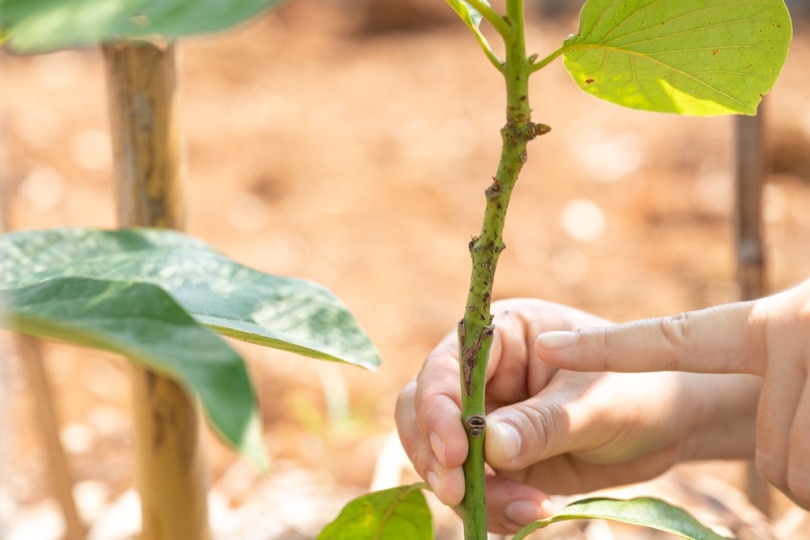How Much & How Often to Water Avocado Trees: Characteristics & Tips
-
Pete Ortiz
- Last updated:

Avocados are bright green to purple fruits with large, rounded seeds. It’s among the favorite ingredients in kitchens across the US because of its various uses. It can be used in salty and sweet dishes and is an excellent addition to a vegetarian or vegan diet. Avocados provide soluble fiber, vitamins, and several valuable minerals such as copper, potassium, and iron.
Besides the excellent health benefits of avocados, these trees are also an exciting addition to any home or garden. There are many ways to grow a healthy and thriving avocado plant, but watering habits are the most crucial part of proper avocado maintenance. Avocados require a specific regime for watering, especially during the early stages of the plant’s growth.
Read the rest of this article to learn more about the adequate amount and frequency of watering your avocado tree.
Avocado Tree Characteristics
| Botanical name: | Persea americana |
| Family: | Lauraceae |
| Genus: | Persea |
| Size: | From 30 to 40 feet |
| Bloom color: | Yellow |
| Bloom time: | March to May |
| Leaves: | Oval, up to 12 inches long |
| USDA Hardiness zones: | Zones 8 to 11 |
| Soil requirement: | Loose, well-aerated soil, pH levels from 6.0 to 6.5 |
| Sun requirement: | 6 hours of full sun exposure per day |
Appearance
Avocados are very tall trees, usually growing between 30 and 40 feet high. The flowers bloom from March until May in the form of dense inflorescences without petals. The avocado trees are famous for their unique, exotic fruit that vary in color, size, and shape. They are usually not bigger than a hen’s egg, although some varieties can weigh as much as 4 pounds. The fruit can be rounded or elongated, and the colors range from green to deep purple. The fruit’s texture is what makes it unique; on the outside, the fruit is coarse and wood-like, and on the inside, it is soft and buttery.

Types and Varieties
There are two main types of avocados—type A and type B. Type A avocados are functionally female in the morning and male in the evening. In contrast, type B is functionally female in the evening and male the next morning. Planting these two types close together helps with cross-pollination and doubles fruit production’s chances.
There are countless avocado varieties depending on the type. The most popular varieties of type A avocados are Hass and Reed, followed by Pinkerton, Lamb Hass, Gwen, Holiday, Mexicola, and Stewart. The most common type B avocado is Fuerte, along with Bacon, Zutano, and Sir Prize.
Origin
The avocado tree originated in southern Mexico and was cultivated in central Peru and the Rio Grande. In the 16th century, the fruit spread across the Atlantic Ocean to Central and South America and then exported to Europe by Spanish explorers. Afterward, the avocado spread throughout the globe and became what it is today. The avocado is grown commercially in the United States, tropical America, Polynesia, Australia, New Zealand, Algeria, South Africa, Israel, Egypt, southern Spain and France, and more.
Risks and Diseases
Avocados are susceptible to many diseases, including the general pathogens and those that target and affect avocados more than other species. The five most common diseases that attack avocados are:
- Verticillium Wilt: Sudden wilting and browning of the foliage, with gray-colored streaks.
- Armillaria Root Rot: Leaves yellowing and falling off, reduced health and strength of the foliage.
- Avocado Black Streak: Poor fruit production, forming cankers, blotchy markings on the leaves.
- Phytophthora Canker: Multiple cankers or lesions on the lower parts of the trunk, leaking reddish sap.
- Dothiorella Canker: Cankers on the trunk and branches, splitting or peeling bark, white powdery discharge.

Watering Habits
Since avocado trees are native to subtropical climates, they are used to receiving large amounts of rainfall. Growing avocado trees in an environment that is more Mediterranean requires proper caring for the tree and good watering habits. When provided with large amounts of water, accurate soil moisture, and well-drained soil, avocados can thrive in zones from 8 to 11.
Still, knowing the exact amount of water and the frequency of watering you need to provide your avocado trees with is crucial. These habits mostly depend on where you choose to grow your avocado tree, whether in the outside garden or a pot. To maintain a healthy growing plant, read on below and find out the proper watering habits for avocado trees.
Watering Planted Avocados
Once you plant avocado in the ground, it will need to receive water multiple times during the week. While the roots are still taking hold and developing in the ground, it is crucial to monitor the soil’s moisture carefully, to know whether to add or reduce the amount of water. This period of the avocado’s growth will be crucial and will determine the future development and health of the tree. A good rule of thumb when checking the soil’s moisture is to grab a handful of soil from around the plant’s roots and squeeze it—if the soil stays in the shape of your hand, it is damp enough, but if it crumbles, your plant needs more water.
Once this first stage passes, an established avocado tree will need much less attention and watering. After a year passes, you can begin watering your avocado tree only once a week, as long as you thoroughly soak the soil under the tree’s canopy. The mature avocado tree requires 2 inches of irrigation or rainfall per week.
Watering Potted Avocados
Growing an avocado tree from just one pit and planting it in a pot can be an incredibly exciting and rewarding process. Before the plant develops roots, it is advised to keep it in a warm and shaded place. Once you notice the first sprouting of the plant—which will happen after about 8 weeks—you can plant the avocado in a pot. It is best to closely watch and monitor the soil’s draining qualities and provide it with water proportionally.
If you place the potted avocado in an area with more direct sunlight and better air circulation, such as a patio or a porch, you will need to water it more frequently. Watering every few days would be an ideal way to keep the soil at an optimal level of moisture, although on some days, the avocado tree may require drier soil.

Additional Avocado Growing Tips
- Avocado trees cannot grow healthy in swampy soil, so proper drainage of the soil is a must.
- Sandy and highly decomposed soil with organic matter is ideal.
- The most significant portion of the avocado roots is established in the top 6 inches of the soil, so it is best to water the young plant twice a week.
- Make sure to watch out for signs of overwatering and root rot which are yellow, brown, or necrotic foliage tips with wilting or drooping leaves.
Final Thoughts
Avocados are lovely additions to your garden and landscape. Besides providing you with healthy and delicious fruit throughout the year, these trees will be an attractive asset. Properly watering avocados during their growing stage is crucial to avocado care. While the tree is still young, you should provide it with a lot of water, two to three times a week. The amount of water will depend on the soil’s drainage, so monitor the soil closely during the first few weeks. After the plant is mature and established, it will require about 2 inches of water every week.
Related Read:
- Avocado Gardening, How To Start, Tips, and Ideas | Agri Farming
- How Much Water Does an Avocado Tree Need? | eHow
- How Much Water Does an Avocado Tree Consume?
- Five Common Diseases of Avocado Trees – Evergreen Arborist Consultants
- How to Grow Avocados: Tree Varieties, Climate, Planting & Care ~ Homestead and Chill
- avocado | Description, Types, History, Uses, & Facts | Britannica.
- Avocado History
Featured Image Credit: sandid, Pixabay
Contents



